COVID-19 Vs H1N1: A Comparison of Trump’s & Obama’s Responses to Pandemic
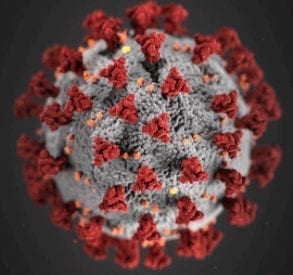
A rendering of the coronavirus using advanced imaging. (Source: CDC)
March 25, 2020 ~ By Shari Rose
During the presidencies of Donald Trump and Barack Obama, global pandemics enveloped the world and affected the everyday lives of Americans from coast to coast. We compare the administrations’ responses to COVID-19 (coronavirus) and H1N1 (swine flu), week by week.
In 2009 and 2020, America faced global pandemics that put massive strains on the healthcare system and national economy. Two different presidents, and their administrations, have approached the threat of pandemic very differently.
H1N1, also known as swine flu, first appeared in California in April 2009, three months into President Obama’s administration. COVID-19, known commonly as coronavirus, first appeared at the end of 2019, about three years into President Trump’s administration.
Beginning chronically from the first day the viruses were identified in the U.S., we compared the governmental actions from both the Obama and Trump administrations as they responded to the threat of pandemic.
- 1st week after initial case is detected in the U.S.
- 2nd week after initial case is detected in the U.S.
- 3rd week after initial case is detected in the U.S.
- 4th week after initial case is detected in the U.S.
- 5th week after initial case is detected in the U.S.
For the 6th week through the 10th week, please check out Part 2 of this series.
1st week after initial case is detected in the U.S.
Obama administration pandemic actions (April 15, 2009 – April 21, 2009)
First case of H1N1 was discovered in California on April 15, 2009.
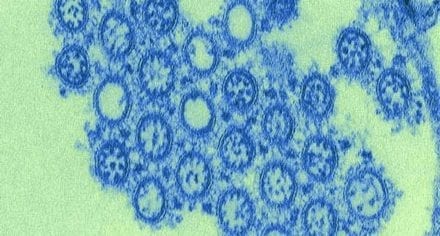
The H1N1 virus under a microscope. (Source: Centers for Disease Control and Prevention)
The first U.S. patient diagnosed with H1N1, or swine flu, was a 10-year-old in California. With this first confirmed case, the Centers of Disease Control and Prevention (CDC) identified a new strain of virus that had not been detected before, a type of swine flu.
Two days later, the CDC confirmed that another young patient tested positive for H1N1 in California. On April 18, the United States reported this new influenza virus to the World Health Organization (WHO). Early reports of severe cases of swine flu in Mexico began trickling in as well.
CDC identifies new strain of swine flu as H1N1
On April 21, the CDC published a public report that identified this swine flu as H1N1 and reported two cases of children who had tested positive. The center also requested that state laboratories send them influenza samples they believe may contain the H1N1 virus.
Director of the CDC’s National Center for Immunization and Respiratory Diseases, Anne Schuchat, told reporters that “we are taking steps to know more and stay on top of the situation.” She also noted that public health officials suspected human-to-human transmission was occurring, which she called “unusual.”
H1N1 numbers by end of first week
By April 21, the World Health Organization identified a few hundred cases of swine flu in Mexico, though estimates remained rough at this time because testing for this new pandemic had just begun. Four people in the U.S. had confirmed cases of H1N1 at this time.
Trump administration pandemic actions (January 21, 2020 – January 27, 2020)
First U.S. case of coronavirus was discovered in Washington state on January 21, 2020.
Unlike the swine flu, coronavirus did not originate in North America, and instead is traced to the city of Wuhan in Hubei province in China. On December 31, 2019, Chinese scientists informed the WHO of a new type of pneumonia, which was later identified as coronavirus. Twelve days later, China released the genetic sequence of the virus, as is standard protocol.
When the first case of COVID-19 in the U.S. was discovered on January 21, Trump was embroiled in an impeachment trial with the U.S. Senate. On Twitter, Trump wrote of his frustrations with the proceedings that day.
When asked by a reporter the following day if he had any concerns about a potential pandemic with COVID-19, Trump responded, “No, not at all. We have it totally under control. It’s one person coming in from China, and we have it under control. It’s going to be just fine.”
On January 23, Trump continued to tweet about the ongoing impeachment trial and Democratic primaries.
Trump writes about coronavirus on Twitter
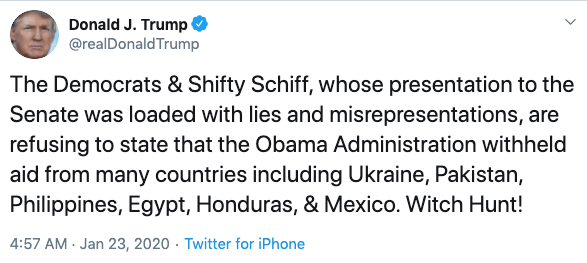 Trump’s first mention of the coronavirus on Twitter occurred on January 24 where he wrote: “China has been working very hard to contain the Coronavirus. The United States greatly appreciates their efforts and transparency. It will all work out well. In particular, on behalf of the American People, I want to thank President Xi!”
Trump’s first mention of the coronavirus on Twitter occurred on January 24 where he wrote: “China has been working very hard to contain the Coronavirus. The United States greatly appreciates their efforts and transparency. It will all work out well. In particular, on behalf of the American People, I want to thank President Xi!”
That same day, the Senate Health Committee held a private meeting with senators and Dr. Anthony Fauci, the country’s leading expert in infectious diseases. At this meeting, senators learned more of the severity of coronavirus and its long-lasting implications in the coming weeks and months. During this time, Trump continued to tweet about Democrats, saying they’re “ angry & “deranged” over the fact that Republicans are up to 191 Federal Judges & Two Great New Supreme Court Justices. Don’t blame me, blame Obama!”
On January 27, Trump tweeted that “We are in very close communication with China concerning the virus. Very few cases reported in USA, but strongly on watch. We have offered China and President Xi any help that is necessary. Our experts are extraordinary!”
COVID-19 numbers by end of first week
By the end of this first week, 5 cases of COVID-19 were confirmed in the U.S. Because the virus had just recently appeared in the U.S. at this time, estimates of cases are very rough. Globally, there were 2,798 confirmed cases and 80 deaths from coronavirus.
2nd week after initial case is detected in the U.S.
Obama administration pandemic actions (April 22, 2009 – April 28, 2009)
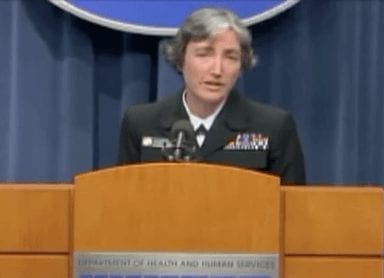
CDC Deputy Director for Science and Public Health Anne Schuchat makes a statement about newly discovered cases of swine flu in California on April 23, 2009. (Source: HHS)
On April 22, the CDC activated its Emergency Operations Center, and confirmed three more cases of the swine flu. The following day, two more cases of H1N1 were uncovered in Texas. It was quickly noted that these individuals did not have any known contact with pigs. Deputy Director for Science & Public Health at the CDC, Anne Schuchat, made a public statement on April 23 to again confirm that two cases of influenza had tested positive for swine flu in California.
On April 24, in following standard protocol the CDC uploaded the complete gene sequences of H1N1 to a public database so that scientists around the world could begin testing their own citizens for swine flu.
The following day, Obama spokesman Reid Cherlin spoke to reporters and said the president had been briefed on the situation in Mexico. He also said “the White House is taking the situation seriously and monitoring for any new developments.”
Obama declares public health emergency
Also on April 25, 8 cases of swine flu were identified in New York. The following day, 11 days after the first case of swine flu was identified in the U.S., Obama declared a public health emergency, which released 25% of the national stockpile of medical equipment to fight the H1N1 virus.
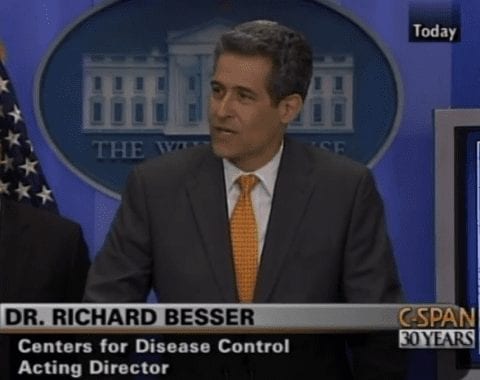
Dr. Richard Besser, acting director of the CDC, speaks about preparations being made for the H1N1 virus on April 26, 2009. (Source: C-SPAN)
Furthermore, the Obama White House put together a press briefing on April 26 that included Homeland Security Secretary Janet Napolitano, Dr. Richard Besser of the CDC, Press Secretary Robert Gibbs, and other officials to discuss the threat from swine flu.
When describing the potential impacts of H1N1, Dr. Besser said, “This is moving fast, but I want you to understand that we view this more as a marathon. We do think that this will continue to spread, but we are taking aggressive actions to minimize the impact on people’s health.”
Continuing, Besser said “It’s important that people understand that there’s a role for everyone to play when there’s an outbreak going on. There are things that individuals do, there’s things that families do, communities do to try and reduce the impact.”
Obama underscores importance of science during pandemics
On April 27, Obama highlighted the importance of science and medical research in a functioning society, saying “Science is more essential for our prosperity, our security, our health, our environment, and our quality of life than it has ever been before.”

Obama speaks about the importance of science during swine flu pandemic on April 27, 2009. (Source: National Academy of Sciences)
He continued: “And if there was ever a day that reminded us of our shared stake in science and research, it’s today. We are closely monitoring the emerging cases of swine flu in the United States … One thing is clear — our capacity to deal with a public health challenge of this sort rests heavily on the work of our scientific and medical community.”
Finishing out the week on April 28, the CDC developed a diagnostic kit able to identify different strains of the influenza A virus. These kits allowed the CDC to confirm a new strain of swine flu, officially identified as 2009 H1N1.
H1N1 numbers by end of second week
Around the end of this second week, U.S. officials confirmed 20 cases of H1N1 in the U.S., with cases appearing in five states. Globally, the WHO reported 148 cases of swine flu in nine countries, with an additional 9 deaths in Mexico.
Trump administration pandemic actions (January 28, 2020 – February 3, 2020)
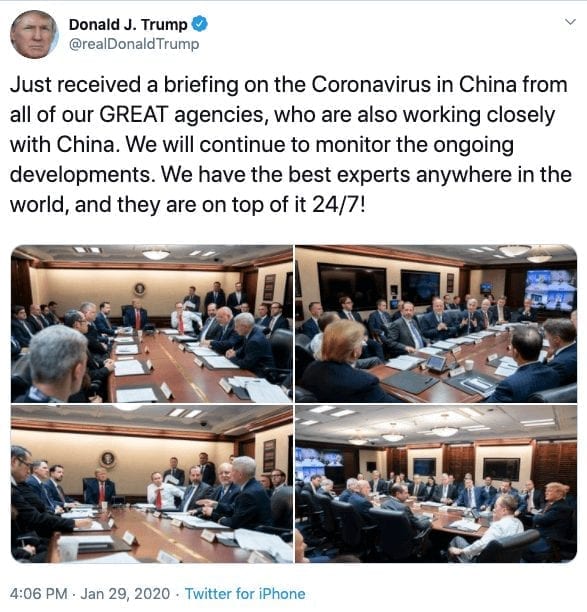 On January 29, Trump tweeted that he “Just received a briefing on the Coronavirus in China from all of our GREAT agencies, who are also working closely with China. We will continue to monitor the ongoing developments. We have the best experts anywhere in the world, and they are on top of it 24/7!”
On January 29, Trump tweeted that he “Just received a briefing on the Coronavirus in China from all of our GREAT agencies, who are also working closely with China. We will continue to monitor the ongoing developments. We have the best experts anywhere in the world, and they are on top of it 24/7!”
The following day, Trump tweeted about coronavirus again, writing “Working closely with China and others on Coronavirus outbreak. Only 5 people in U.S., all in good recovery.”
That same evening, Trump held a rally for himself in Iowa.
However, still on January 30, the CDC publicly confirmed the first person-to-person spread of the coronavirus. It identified the first case of a person who had coronavirus and no known travel to China or other countries with known outbreaks. Instead, the Illinois resident lived in the same home as someone who tested positive for the virus, and contacted it from them.
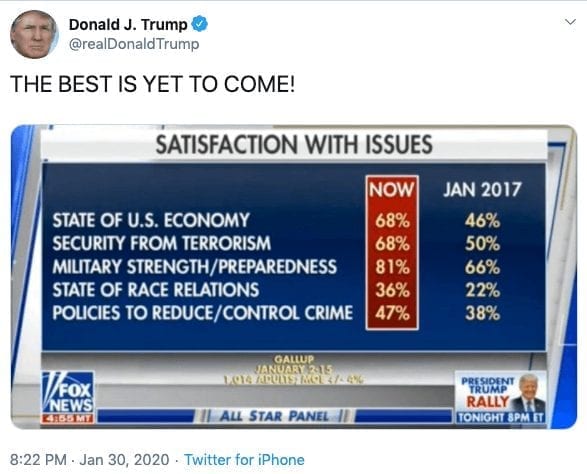
Secretary Alex Azar declares public health emergency
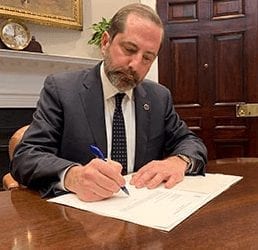
Sec. Alex Azar declares public health emergency in response to coronavirus on January 31, 2020. (Source: Health and Human Services)
On January 31, Secretary of Health and Human Services Alex Azar declared a public health emergency. In addition, Azar announced 14-day quarantines for Americans who visited the Hubei province in China. Finally, any non-U.S. citizen who recently visited China would be barred from entering the country. The same day, the S&P 500 Index fell 2.1 percent.
On February 1, Trump continued to tweet about “phony Witch Hunts” and said “Tens of thousands of people attending rallies (which the Fake News never mentions) to see “The Greatest Show On Earth”. Fun because USA is WINNING AGAIN!”
Two days later, Trump continued to focus on his impeachment trial, lashing out on Twitter:
“I hope Republicans & the American people realize that the totally partisan Impeachment Hoax is exacty that, a Hoax. Read the Transcripts, listen to what the President & Foreign Minister of Ukraine said (“No Pressure”). Nothing will ever satisfy the Do Nothing, Radical Left Dems!”
COVID-19 numbers by end of second week
The same day, there were 11 confirmed COVID-19 cases in the U.S. Globally, the WHO confirmed 17,391 cases and 362 deaths by February 3.
More stories: The Legend Of Sadie The Goat in 1860s New York City
More stories: The First Laugh Ceremony: A Joyful Navajo Celebration of Family
3rd week after initial case is detected in the U.S.
Obama administration pandemic actions (April 29, 2009 – May 5, 2009)
On April 29, Obama held a press conference about the domestic threat from H1N1. He said the swine flu is “a cause for deep concern, but not panic. And I think that we have to make sure that we recognize that how we respond — intelligently, systematically, based on science and what public health officials have to say — will determine in large part what happens.”
During that press conference Obama requested $1.5 billion for emergency funding from Congress to tackle the virus, from building up reserves for antiviral drugs, to providing personal protective equipment (PPE) for health care workers and finding treatments for H1N1.
Widespread H1N1 testing kits shipped across the U.S.

Anne Schuchat, deputy director for Science & Public Health at the CDC, speaks about H1N1 in the U.S. on May 1, 2009. (Source: C-SPAN)
Two days later, on May 1st, 2009 ,the CDC began shipping test kits for the swine flu throughout the nation’s public health laboratories. Each test kit contained 1,000 individual tests. With more than 1,000 test kits that shipped out, the CDC sent more than one million H1N1 test kits throughout the United States and about 140 countries. The U.S. was the internal leader in providing test kits all over the world during this time.
And because of the greater access to testing, states no longer had to wait for the CDC to confirm the presence of H1N1 – they could have the results for themselves, cutting down massively in waiting times for swine flu test results. In the month of May, scaled-up testing went into effect and thousands of Americans began to be tested for the swine flu each day.
On May 2, Obama spoke about the swine flu during his weekly address:

Obama speaks in a weekly address about the H1N1 situation in the U.S. on May 2, 2009. (Source: White House Archives)
“It is my greatest hope and prayer that all of these precautions and preparations prove unnecessary. But because we have it within our power to limit the potential damage of this virus, we have a solemn and urgent responsibility to take the necessary steps.”
“I have no higher priority as President of the United States than the safety and security of the American people, and I will do whatever is necessary to protect this country. So I want to thank every American for their patience and understanding during this developing challenge, and I promise that this government will continue speaking clearly and honestly about the steps we’re taking to meet it.”
H1N1 numbers by end of third week
By May 5, there were 286 confirmed cases of H1N1 across 36 states. Internationally, the WHO reported 1,124 cases of H1N1 swine flu.
Trump administration pandemic actions (February 4, 2020 – February 10, 2020)
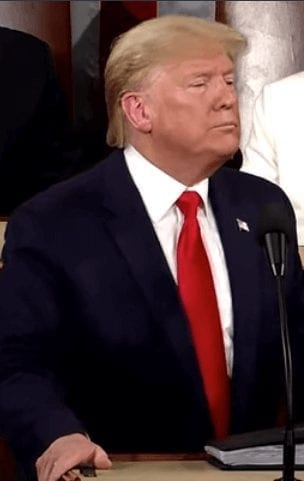
Trump makes brief remarks about coronavirus during his State of the Union speech on February 4, 2020.
On February 4, Trump returned to Twitter to highlight his approval ratings. “My Approval Rating in the Republican Party = 95%, a record! Big Iowa win. Approval Rating overall = 53%, a new high. With our great Economy and other major successes, would be 20 points higher without the phony Witch Hunts and Hoaxes???”
The same day, Trump gave his State of the Union speech. His comments in full about the coronavirus are below:
“Protecting Americans’ health also means fighting infectious diseases. We are coordinating with the Chinese government and working closely together on the Coronavirus outbreak in China. My Administration will take all necessary steps to safeguard our citizens from this threat.”
Trump later tweeted his support for China’s president in fighting coronavirus on February 5. Trump said he believes China will be successful “especially as the weather starts to warm & the virus hopefully becomes weaker, and then gone.”
The same day, the CDC released an updated report about coronavirus in the U.S. It called for “A coordinated national effort to diagnose 2019-nCoV among persons at high risk for infection” in an effort to “limit transmission in the United States.
First American dies of coronavirus
The first U.S. citizen to die from coronavirus passed away on February 7 in China. Additionally, the State Department announced that it had sent “nearly 17.8 tons of donated medical supplies to the Chinese people, including masks, gowns, gauze, respirators, and other vital materials.” As it turns out, national calls for personal protective gear, such as masks, as well as life-saving ventilators, will reach a fever pitch in the U.S. in the next month, as medical supplies run dangerously low in this country.
 On February 9, Trump continued to write about the impeachment trial that concluded four days prior, with his acquittal:
On February 9, Trump continued to write about the impeachment trial that concluded four days prior, with his acquittal:
“SIMPLY PUT, THE PARTY IN POWER ILLEGALLY SPIED ON MY CAMPAIGN, BOTH BEFORE AND AFTER THE ELECTION, IN ORDER TO CHANGE OR NULLIFY THE RESULTS OF THE ELECTION. IT CONTINUED ON WITH THE IMPEACHMENT HOAX. Terrible!”
Also on February 9, Chinese health officials announced that the global death toll from coronavirus surpassed the total number of deaths attributed to the SARS outbreak in 2002 and 2003.
Trump speaks with state governors
The next day, Trump attended a rally for himself in Manchester, NH and tweeted that “All States are doing well. “Thank you Mr. President.”
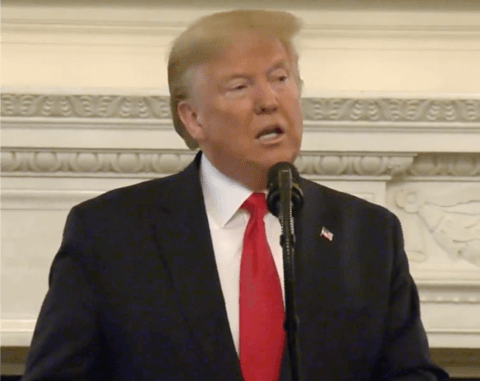
Trump speaks during a Governor’s Business Session at the White House on February 10, 2020. (Source: White House)
While addressing a Governor’s Business Session at the White House, Trump floated a theory that coronavirus will disappear as the weather gets warmer. He said “You know, a lot of people think that goes away in April with the heat — as the heat comes in. Typically, that will go away in April.” He said this to state governors worried about their residents.”
However, scientists say there is no evidence that’s true.
COVID-19 numbers by end of third week
On February 10, there continued to be 11 confirmed cases of coronavirus. It should be noted though this number is not due to containment of the virus, but rather a lack of national testing kits in the U.S. that kept numbers artificially low for a number of weeks. Globally, there were 40,554 confirmed cases of COVID-19, and 910 deaths to date.
4th week after initial case is detected in the U.S.
Obama administration pandemic actions (May 6, 2009 – May 12, 2009)
The first U.S. death from swine flu occurred on May 6 in Texas. The same day, the Obama administration announced plans to distribute a vaccine for the H1N1 in the next six months.
Robin Robinson, a top official with the Department of Health and Human Services, confirmed the plan: “We are moving forward with making a vaccine.”
Though some House Republicans pushed back on the CDC’s recommendation for $1.5 billion to ensure the country has a vaccine for swine flu by the fall, the measures were passed, and public health officials ramped up testing and eventual production of the vaccine.
Because pandemic experts widely expected cases of swine flu in the U.S. to spike by the end of the year, the Obama administration made this push to have a vaccine up and running as soon as possible.
H1N1 numbers by end of fourth week
As of May 8, the WHO confirmed 896 cases of H1N1 in the U.S., and two deaths. There were 2,500 confirmed cases of H1N1 across the globe at this point.
Trump administration pandemic actions (February 11, 2020 – February 17, 2020)
Four weeks after COVID-19 was discovered in the U.S., Trump continued to highlight the economy and his approval ratings on Twitter. On February 11, he wrote “BEST USA ECONOMY IN HISTORY!” Later that week, he wrote “95% Approval Rating in the Republican Party. Thank you!”
At the U.S. Capitol, however, senators met together for a Homeland Security meeting about the growing threat of the coronavirus. Senators later wrote that “no current Trump administration public health officials attended.”
On February 17, Trump tweeted: “Did you hear the latest con job? President Obama is now trying to take credit for the Economic Boom taking place under the Trump Administration. He had the WEAKEST recovery since the Great Depression, despite Zero Fed Rate & MASSIVE quantitative easing. NOW, best jobs numbers….”
COVID-19 numbers by end of fourth week
By February 17, 13 cases were confirmed to be COVID-19 in the U.S. Calls for widespread testing for coronavirus continued to grow louder from health officials and doctors across the country to better understand the scope of the pandemic. Throughout the world, there were 71,429 confirmed cases of COVID-19, and 1,775 deaths.
More stories: The Cruelty of U.S. Migrant Detention Facilities in 2020
More stories: Living Statues of Trump Appear in DC as Form of Protest
5th week after initial case is detected in the U.S.
Obama administration pandemic actions (May 13, 2009 – May 19, 2009)
Four Americans were confirmed dead from the swine flu on May 15.
By May 18, 40 states were able to perform their own testing for the swine flu. As a result, the CDC predicted that the number of cases would probably spike as more people were tested for H1N1, but the true impact of the pandemic could be measured far more accurately.
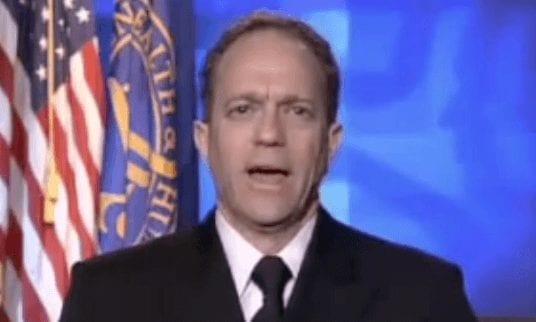
Acting Surgeon General Dr. Steven Galson shares the CDC’s recommendations for protection against the H1N1 swine flu on May 19, 2009.
The following day, Acting Surgeon General Dr. Steven Galson appeared on camera to again share the CDC’s recommendations for protecting oneself against swine flu. These included washing your hands, remembering not to touch your face, and staying home from work or school if you are feeling ill.
H1N1 numbers by end of fifth week
As widespread testing flourished in the U.S., 5,000 cases of swine flu were confirmed, and five people in the country had died by May 19. The WHO reported 9,830 global cases of H1N1, and 79 deaths.
Trump administration pandemic actions (Feb 18, 2020 – Feb 24, 2020)
During the fifth week, Trump continued to tout the economy and attack Democrats. On February 19, he tweeted, “Highest Stock Market In History, By Far!”
Three days later, Trump tweeted about the Democratic primaries: “Democrats in the Great State of Nevada (Which, because of the Economy, Jobs, the Military & Vets, I will win in November), be careful of Russia, Russia, Russia. According to Corrupt politician Adam “Shifty” Schiff, they are pushing for Crazy Bernie Sanders to win. Vote!”
On February 24, Trump tweeted about coronavirus, saying it “is very much under control in the USA.”
That same day, the S&P fell 3.4%, its worst day since February 2018.
In addition, the Trump administration asked Congress for $1.8 billion in emergency spending to help fight the spread of the coronavirus.
COVID-19 numbers by end of fifth week
On February 24, there were 15 confirmed cases of COVID-19 in the U.S, though public officials continued to reiterate that the actual number of cases was actually much higher, but without widespread testing for coronavirus, doctors remained in the dark about the true number of cases. Calls for national testing grew louder still. Globally, there were 79,331 confirmed cases of COVID-19, and 2,618 deaths by February 24.

Continue reading for Weeks 6 – 10 at Part 2 of COVID-19 Vs H1N1: Trump & Obama Responses on Blurred Bylines.
Share this story
 |
 |
 |
 |
 |
 |







0 Comments